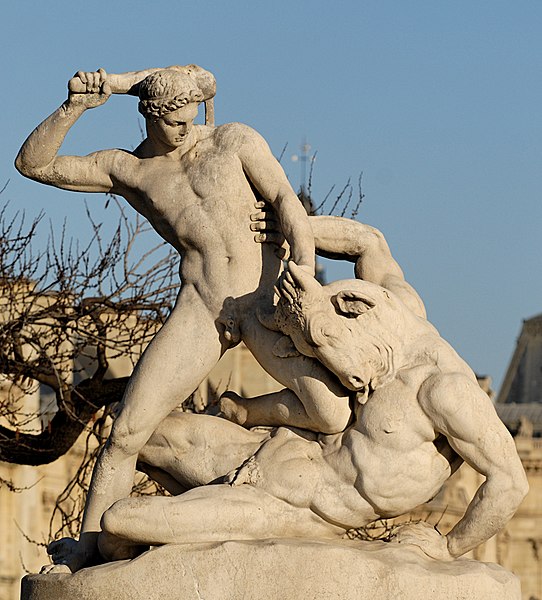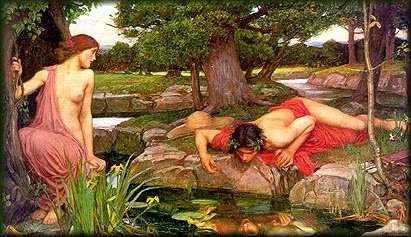Medea was a figure of myth long before Tyler Perry stole the name for a series of extremely low brow comedies. In fact, I found myself quite annoyed when I went to google to find images for a mythology paper. The first few pages were nothing by images form Tyler Perry movies. Aggravating...
But I digress.
Medea was a play written by Euripides. The story is ever so interesting. In my mythology class I was assigned the play and had to give a presentation.I'm not the best public speaker, but I was fairly effective. Anyway, Medea is most commonly referred to as she exists within that specific play by her name, but she does appear in several other stories. Her major characteristics are that she was a sorceress and lover of Jason (the guy with the golden fleece).
She was the daughter of King Aeetes, granddaughter of Helios (the sun god), and niece of Circe (who was depicted in
Odyssey for turning Odysseus's crew into pigs, she is also the mother of the minotaur). As you see she has a colorful lineage.
So Jason appears on her island to capture the golden fleece. Medea falls hopelessly in love with him and agrees to help him on his quests.
Medea creates a potion for Jason that prevents him from being injured by the fire-breathing bulls and then casts an enchantment over the dragon guarding the golden fleece so Jason can get by undetected. Basically...he cheated. When he completes the missions he agrees to take Medea away with him and marry her. As they are leaving the island Medea kills her brother, Apsyrtus, and scatters his body in pieces behind them. This slowed their pursuers down as it is dishonorable to leave the body in such a state.

Once in Jason's home of Iolcus Medea used her trickery to help him reclaim his throne from his uncle Pelias. Using magic tricks she convinced Pelias's daughters to kill him which opened up the place for Jason. Then they fled to Corinth. Shortly after this they were wed and had two children. This is where the story gets more interesting.
So they have been married for awhile, living comfortable in Corinth until Glauce, daughter of King Creon, catches Jason's eye. Jason then runs off with her in order to become next in ling to the throne in Corinth. Then he and the king have Medea cast out. With this betrayal Medea snaps. She devises a plan that results in the death of Glauce and the King, then she kills her own children to punish Jason further. Before she can be punished for her own actions she is rescued by her grandfather and ushered off the Athens where she marries King Aegeus, who we suspect she had been in cahoots with all along. Then they marry and her trail of despair and death continues.
But I intend to focus more on the play by Euripides.While there is certainly no argument claiming Medea was a good woman who was wrong, you have to take into consideration what Jason did. He first used her in order to complete some tasks and promised her marriage later, getting her to kill her own brother. Then he does marry her and has children with her only to leave her and cast her out later? If there was a douche by any other name...pardon my comparison.
But if we take the fact that she was essentially an evil wizard out of the equation do you feel even the slightest bit of compassion? I certainly did, but once she murdered her children it faded away. And by faded I mean disappeared with the snap of my fingers (assuming I could snap my fingers). Then there's Glauce...pursuing a married man? For shame. This is something I would expect to see on trashy daytime television, though I suppose this behavior had to begin somewhere. But it seems Medea is simply a woman scorned.
Wouldn't you agree? I'm not defending the things she did, but I am saying that I can see where the desire might occur. If Joshua left me for another woman I would be destroyed and livid.
But this is one of the many endlessly entertaining myths I fill my time with studying. Sometimes it helps to identify to them. Echo served as a therapeutic comparison for a short time for myself.
I honestly need to start working on my homework instead of blogging about things I doubt very few people read.
Life updates:
I have resolved to get a tattoo. It will be a chambered nautilus shell, the proportions and measurements found using the golden ratio. Perfect balance. Done in dark brown ink on the inside of my left wrist. I will be going with my darling Christine when she gets her tattoo done. She is getting giraffe spots on the inside of her left wrist as well. Though more to cover up the tattoo she allowed her ex-boyfriend to give her. It is a simple peace sign (I love here but that is horrible cliche...) but something she wishes to forget all the same.
images:
Study for Jason and Medea by John William Waterhouse (top)
Medea by Eugene Delacroix
 This piece is theorized to teach initiates how the sun was pulled across the sky since they seem to believe it wasn't made purely for ornament or decoration (I think it easily could have been). According to Norse mythology Sol is the goddess of the sun. She would ride through the sky on her chariot pulled by her horses Arvak and Alsvid. Quite similar to the Greek Helios.
This piece is theorized to teach initiates how the sun was pulled across the sky since they seem to believe it wasn't made purely for ornament or decoration (I think it easily could have been). According to Norse mythology Sol is the goddess of the sun. She would ride through the sky on her chariot pulled by her horses Arvak and Alsvid. Quite similar to the Greek Helios.










